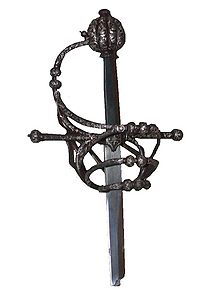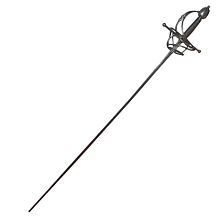Rapier sword

The term "rapier sword" arose in the Renaissance in Spain to designate a certain class of sword with a straight and long blade, wielded with one hand. The original Spanish name for the rapier sword is tizona (not to be confused with the Cid's sword). It is called a rapier sword because it was carried as an accessory to clothing, generally used for fashion and as a self-defense weapon.
Her name is of Spanish origin and appears recorded for the first time in the Coplas de la panadera, by Juan de Mena, written between approximately 1445 and 1450:
Say, Panadera.
A Wednesday to leave
Prince Henry
to find some good fish
for his sword closet,
go out without another wait
of Olmedo so great attire,
with mui fermosa maña
To the Port is retruded.
Another document in which a rapier is cited is the inventory of objects belonging to Duke Álvaro de Zúñiga (1468). The fact that the term is of Spanish origin does not imply that the development of this type of sword has occurred in Spain, since the process is complex and involves traditions and workshops from all over Europe. On the other hand, the Italians have their own terms for this type of weapon: spada da lato (circa 1450 to 1600) and spada da lato a striscia or more simply < i>striscia (from 1600 onwards, but some prototypes date to 1550).
In France, the rapier (the rapière) was first mentioned in documents around 1474. Edwart Oakeshott, in his book European Weapons and Armour, indicates that by the early 16th century the term was well established in France, and was soon adopted by the English. However, this class of sword had detractors such as George Silver, who opposed its use for tempting men to duel.
Its period of maximum splendor could be placed between approximately 1525 and 1675, being progressively replaced by the typical sprat of the XVIIIth century, of French origin.
At least in the 16th century, a rapier was not just a weapon for pointed use only, but with blade of narrow and sharp section. Actually, in the Spain of the time, any sword intended for use in mourning and clothing, accompanying the clothing of a civilian (or a soldier in civilian dress), was called a rapier, thus being outside this category. denomination only the purely military swords, with a simple garnish. Therefore, during this period we find elaborate lace garnishes, accompanying relatively wide blades, appropriate for both pointed and cutting use, and we will still be in front of a rapier. Even at the end of the following century (already around 1660-80), when blades with a fine quadrangular or rhomboid section (called verduguillos) were common currency, some broad-bladed civilian swords were back in fashion in Spain, always mounting their own fittings. of authentic rapier swords.
Morphology
There are three types of garnishes that we should consider: lasso, shell and cup garnishes, which consecutively provide greater protection to the hand that wields them.
A bow garrison is made up of the hawks (the cross, properly speaking), long and generally not very thick, an arched handguard that protects the knuckles, one or two rings perpendicular to the plane of the blade, and a series of branches that unite all these elements together on the obverse or exterior zone, and on the reverse or interior zone of the lining. Not all of these elements must necessarily be present, and for this reason some authors classify this type of trim as quarter-loop, half-loop, three-quarter and full-loop, depending on the number of these elements present. This garnish, common between 1550 and 1620 approximately, has its origins in the sideburn garnishes of the late XV century, and was really effective to stop cuts, but in some cases the tip of the rival could enter between the different branches and hurt the hand that wielded the weapon. For this reason, relatively thick leather gloves used to be used when fighting with this type of sword.
As fencing evolved towards greater use of the point, greater hand protection became necessary, so metal plates (shells) were frequently added between the rings of the lasso fitting. Over time these shells were formed by a single piece of bilobed sheet iron or steel, which was attached to the cross by means of a pair of pins. Thus was born the shell garnish, typically Spanish, practical and resistant, and which would enjoy an extremely long period of popularity.
To further increase the protection of the hand, other practically contemporary garnishes to those made of shells presented not a bilobed plate, but an authentic hemispherical cap, which in practice took the shape of a bowl or cup, equally supported for a pair of sideburns. This cup, which gives its name to this type of trim, together with the quillons and the fore-end, offered a maximum level of protection for the hand, while at the same time being quite light. Its use essentially spread throughout Spain and Italy, lasting well into the 18th century. It is the classic garnish that would be mentally associated with a rapier.
Fencing Techniques
The rapier, while not heavy or cumbersome to handle, is certainly not the kind of weapon you see in "musketeer" movies. Rapier-style garnishes (usually cup) often appear in the cinema attached to épée or foil blades of modern sports fencing, somewhat shorter and much lighter and more flexible than the authentic original blades. The rapier was a weapon of considerable dimensions (some blades easily exceeded one meter in length). The measurement varies according to the size of the person: at one point its size was standardized, determining that the length of the blade added to the length of the arm should be equal to the height of the person, and an appreciable weight (close to one kilogram), so your fencing must accommodate this fact. For example, actions usually occur in a single time (joining the stop and the response in a continuous movement), given their greater inertia.
Even so, a good period piece that maintains all its original elements (fitting, handle and pommel) is endowed with such a perfect balance that it makes it much faster in the hand than its dimensions might suggest at first glance. The balance point of these swords is usually located about four fingers from the garrison, although this is highly variable and depends on the intended use for each piece (that is, favoring exclusively point fencing or allowing its use for cutting).
The Spanish school of rapier fencing is called true skill, founded on the theoretical foundations established by Jerónimo Sánchez de Carranza in his work Of the Philosophy of Weapons and their Skill and Aggression and Christian Defense< /cite>, published in 1569. These principles were collected and perfected by Luis Pacheco de Narváez, master-at-arms of Felipe IV of Spain, who published up to eleven fencing treatises, the most important being Libro de las grandesas de la sword (1600), One Hundred Conclusions on Weapons (1608) and New Science and Philosophy of Weapons Skills (1632).
Contenido relacionado
Yahagi (1943)
Prinz Eugen (1940)
Bow and arrow
Did you mean: Máuser 98
V2 rocket


